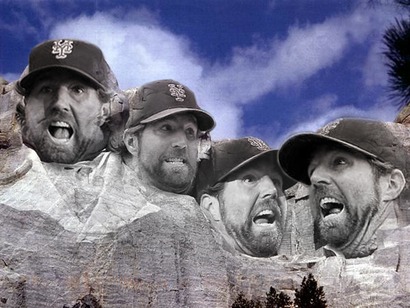 |
| How does he do it?! I'm thinking it's the crazy eyes. |
In a special investigative segment, TDZ chases down Dickey's fluttering butterfly pitches to find out how they are so elusive. The answer just might shock you.
As I usually do when analyzing players, I delve into the numbers, for which FanGraphs is a trusty source. The first thing I look at is BABIP to see if he's been lucky. At .240, he's been lucky, but it's only about 35 points below his level from recent years, so even if that corrects he's still a very good pitcher.
Then I moved on to another component of WHIP and noticed his walk rate. At 6%, it's rather low, especially for a knuckleballer as it means he's able to keep it under control pretty well. Still, that's also consistent with previous years. Something else has to be different.
Well, there's a crucial aspect of opposing batter OPS, and that's slugging percentage. A quick glance at his HR allowed rate shows that he's consistent there too. What gives?
 |
| I hadn't considered that his advantage was auditory. Howl on. |
 |
| I'm telling you, the crazy eyes play. |
For those not familiar with Dickey's career, he didn't use to be a knuckleballer. He started throwing it in 2005, in his fourth major league season. He basically reinvented himself and created a new high velocity knuckleball to try to stay relevant in the league. At this point he's moved on from mere relevance to super stardom.
2. Balls
One key difference between R.A. Dickey and previous knuckleballers is that he throws his harder than them. He regularly throws a fast knuckleball in the upper 70's, and it's not uncommon to see it hit the 80's. For comparison, Wakefield's classic "fastball" was 74 mph on average, and his knuckler was 66.5 mph.
Why do I think that takes cajones? Because the faster you throw a knuckleball, the less it moves. The safe move is to strain your body less and let it flutter as much as possible. The results show that the move has paid off, as with each year he's thrown it harder (on average) and performed better as hitters have less time to react to the erratic, if less fluttering, pitch.
3. Brains
While the first two explain how Dickey might be different from previous knuckleballers, it doesn't explain his immense success this year relative to previous years. This third reason is really the reason for his success in this blogger's humble opinion.
There's been a lot of reports that Dickey has sped up his knuckleball, throwing it even faster than in past years. Technically, that's true: it's 1 mph faster. I don't buy that that accounts for the massive uptick in K rate by itself. Partly, but not entirely.
 |
| Truth time: Dickey went on pilgrimage to Kashyyk and learned a special Wookie-grip that hitters haven't figured out yet. |
As mentioned, he has a fast knuckleball that's typically 78+ mph, but he also has two other knuckleballs that travel at slower speeds: one that's at a more typical 74-76 mph, and one that's extra slow at 72 mph and below. The 1 mph rise in his pitch velocity, though minor, starts to mean more when coupled with the fact that he can intentionally adjust the speed to disrupt a hitter's timing. This is much in the same way a faster fastball enhances the effectiveness of a slower change-up, and vice versa. I argue that it's not just about the higher velocity: it's about the way he mixes speeds. That, along with his plus-control of a generally unpredictable pitch, is responsible for his immense success.
It is folly to think that knowing when and how much to change speeds can't account for such success. Consider veterans like Jamie Moyer and Bruce Chen. They were able to carve out very decent careers in the Bigs by being cagey with the selection and location of their below average fastball and off-speed offerings. What stops Dickey from being even more successful with an utterly unique knuckleball that is actually unpredictable and also changes speeds?
 |
| Everything's got to come back to Jamie Moyer with you, doesn't it. |
No comments:
Post a Comment